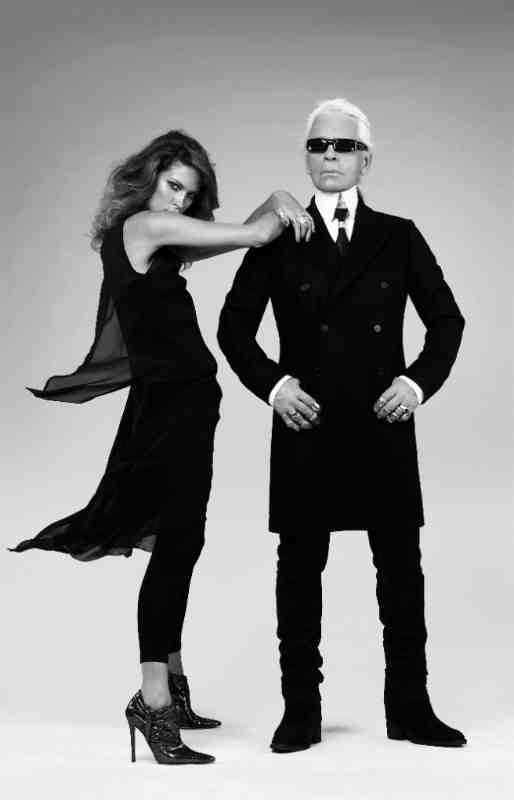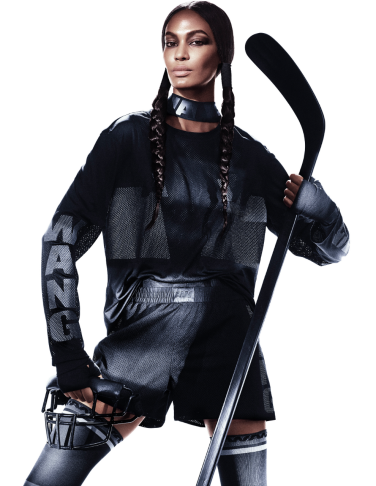ABOUT STOP PRESS
Stop Press is ISBN Magazine’s guide to happenings in Hong Kong. From art to auctions and from food to fashion, to entertainment, cinema, sport, wine and design, scroll through the best of the city's dynamic cultural offerings. And if your event merits mention in our little book of lifestyle chic, write to us at stoppress@isbn-magazine.com
H&M Collaborations @ 10
 "Mass elitism, which has long been my dream, is the future of modernity," said Karl Lagerfeld, on the eve of his groundbreaking fashion collaboration with Sweden's H&M in 2004. The aim, a kind of 'massclusivity', was to create an exclusive product on a limited-edition basis. The result - his clothes sold out in 25 minutes in New York - shifted the fashion/retail paradigm, of the industry, designers and consumers.
"Mass elitism, which has long been my dream, is the future of modernity," said Karl Lagerfeld, on the eve of his groundbreaking fashion collaboration with Sweden's H&M in 2004. The aim, a kind of 'massclusivity', was to create an exclusive product on a limited-edition basis. The result - his clothes sold out in 25 minutes in New York - shifted the fashion/retail paradigm, of the industry, designers and consumers. "We've been operating this business for 60 years and we've never seen anything like it," said Jorgen Andersson, marketing boss of H&M at the time. "We are as surprised as the customer [at the rapid sellout]." Lagerfeld was left bemoaning its astonishing success: "I'm sorry for the clients because I like the idea that everyone could wear Lagerfeld." The three top hits were a Lagerfeld silhouette T-shirt (US$19.90); a sequin jacket ($129), and a lace dress ($99.90). Later that day, 69 of the products were already selling on eBay. Women's jeans at $59.90 were selling for $75. "H&M has made inexpensive desirable," concluded Karl."Today, this is fashion".
This year H&M sought out Alexander Wang, who designs his own brand, and for Balenciaga. It was the Swedish e-, re-, and ubiqui-tailer's first collaboration with an American. Despite being released in November, the project was announced in April, and by July, taking advantage of social media, a first knock-out product was posted on H&M's Twitter account: an Alexander Wang-branded boxing glove keyring. Vogue ran a 'look book' of products in October calling the strappy scuba dresses, cropped bra-tops and leather joggers a "sporty-minded fantasy".

And on November 6th, six months of selective 'Instagrammable' social media marketing later, H&M stores launched the H&M/Alexander Wang collaboration (right). Wang's cutting-edge, logo-laden 'athleisure wear', which contained elements of his spring/summer 2015 campaign, sold out in 45 minutes, with some pieces selling online within the hour. Wang, like Lagerfeld, was left applauding H&M's style: "they push boundaries and set a platform for creativity," he said.
H&M is a game-changer, not just as fashion democratizer of the high street, but also of electric avenue. The retailer saw the value of a mass e-porium, and introduced a virtual dressing room in 2006, whereby shoppers could 'try' clothes on a virtual model designed to look like them. The technology has since been refined and the latest iteration lets shoppers change the hairstyle and expression of virtual models, dress them in myriad H&M looks, button and unbutton clothes on them, rotate the models to see silhouettes front and back, and even choose the most appropriate skin colour. Shoppers get to play stylist and creative director before they buy; it's retail rebooted as added-value purr-chase.
That exposure worked especially for Japan's Rei Kawakubo at Comme des Garçons (2008 - left), H&M's most avant-garde choice. "I thought it would be exciting to work with H&M to sell CdG clothes in new markets and appeal to consumers who, up until now, may not have been familiar with the CdG concept. Pairing H&M's international design expertise with Comme des Garçons' creations has resulted in a fascinating accomplishment," Kawakubo said. "The coming together of two contrasted histories, asethetics, ideas leads often to something greater than the sum of its parts."
An unsung voice central to all collaborations is H&M creative advisor Margareta van den Bosch. She instigated the majority, and despite 'retiring' from H&M several years ago, continues to oversee the projects. "They are all important and exciting projects for us. We like to surprise by doing the unexpected. Karl Lagerfeld, master of couture, street-cool Stella, Viktor & Rolf with their modern twist on tailoring, Roberto Cavalli, glamorous and extravagant, and then Rei Kawakubo: always pushing the frontiers of design and never accepting the status quo. It has been an amazing journey." Does she have a favourite? "I have millions of fantastic memories at H&M and I'm still collecting new ones. My first encounter with Karl Lagerfeld was memorable. He was extremely aimiable and just the perfect host. The collaboration with him was a real pleasure."
A book commemorating H&M's decade of fashion democratization has been released, 25 percent of which goes to UNICEF's work against child marriage. With behind-the-scenes pictures, campaign visuals, interviews with all designers and key pieces from each collection, it's playfully titled, too. The First Ten Years. "I like the constant change, the humour, the open attitude, the classic fashion designers and tailors as well as the hyped-up stars, the beautiful and the strange - sometimes even the ugly," says van den Bosch of the business. "Fashion should be fun, feeling good about yourself." Here's to the next decade.
Images: Courtesy of H&M
H&M Collaborations @ 10
 "Mass elitism, which has long been my dream, is the future of modernity," said Karl Lagerfeld, on the eve of his groundbreaking fashion collaboration with Sweden's H&M in 2004. The aim, a kind of 'massclusivity', was to create an exclusive product on a limited-edition basis. The result - his clothes sold out in 25 minutes in New York - shifted the fashion/retail paradigm, of the industry, designers and consumers.
"Mass elitism, which has long been my dream, is the future of modernity," said Karl Lagerfeld, on the eve of his groundbreaking fashion collaboration with Sweden's H&M in 2004. The aim, a kind of 'massclusivity', was to create an exclusive product on a limited-edition basis. The result - his clothes sold out in 25 minutes in New York - shifted the fashion/retail paradigm, of the industry, designers and consumers. "We've been operating this business for 60 years and we've never seen anything like it," said Jorgen Andersson, marketing boss of H&M at the time. "We are as surprised as the customer [at the rapid sellout]." Lagerfeld was left bemoaning its astonishing success: "I'm sorry for the clients because I like the idea that everyone could wear Lagerfeld." The three top hits were a Lagerfeld silhouette T-shirt (US$19.90); a sequin jacket ($129), and a lace dress ($99.90). Later that day, 69 of the products were already selling on eBay. Women's jeans at $59.90 were selling for $75. "H&M has made inexpensive desirable," concluded Karl."Today, this is fashion".
This year H&M sought out Alexander Wang, who designs his own brand, and for Balenciaga. It was the Swedish e-, re-, and ubiqui-tailer's first collaboration with an American. Despite being released in November, the project was announced in April, and by July, taking advantage of social media, a first knock-out product was posted on H&M's Twitter account: an Alexander Wang-branded boxing glove keyring. Vogue ran a 'look book' of products in October calling the strappy scuba dresses, cropped bra-tops and leather joggers a "sporty-minded fantasy".

And on November 6th, six months of selective 'Instagrammable' social media marketing later, H&M stores launched the H&M/Alexander Wang collaboration (right). Wang's cutting-edge, logo-laden 'athleisure wear', which contained elements of his spring/summer 2015 campaign, sold out in 45 minutes, with some pieces selling online within the hour. Wang, like Lagerfeld, was left applauding H&M's style: "they push boundaries and set a platform for creativity," he said.
H&M is a game-changer, not just as fashion democratizer of the high street, but also of electric avenue. The retailer saw the value of a mass e-porium, and introduced a virtual dressing room in 2006, whereby shoppers could 'try' clothes on a virtual model designed to look like them. The technology has since been refined and the latest iteration lets shoppers change the hairstyle and expression of virtual models, dress them in myriad H&M looks, button and unbutton clothes on them, rotate the models to see silhouettes front and back, and even choose the most appropriate skin colour. Shoppers get to play stylist and creative director before they buy; it's retail rebooted as added-value purr-chase.
That exposure worked especially for Japan's Rei Kawakubo at Comme des Garçons (2008 - left), H&M's most avant-garde choice. "I thought it would be exciting to work with H&M to sell CdG clothes in new markets and appeal to consumers who, up until now, may not have been familiar with the CdG concept. Pairing H&M's international design expertise with Comme des Garçons' creations has resulted in a fascinating accomplishment," Kawakubo said. "The coming together of two contrasted histories, asethetics, ideas leads often to something greater than the sum of its parts."
An unsung voice central to all collaborations is H&M creative advisor Margareta van den Bosch. She instigated the majority, and despite 'retiring' from H&M several years ago, continues to oversee the projects. "They are all important and exciting projects for us. We like to surprise by doing the unexpected. Karl Lagerfeld, master of couture, street-cool Stella, Viktor & Rolf with their modern twist on tailoring, Roberto Cavalli, glamorous and extravagant, and then Rei Kawakubo: always pushing the frontiers of design and never accepting the status quo. It has been an amazing journey." Does she have a favourite? "I have millions of fantastic memories at H&M and I'm still collecting new ones. My first encounter with Karl Lagerfeld was memorable. He was extremely aimiable and just the perfect host. The collaboration with him was a real pleasure."
A book commemorating H&M's decade of fashion democratization has been released, 25 percent of which goes to UNICEF's work against child marriage. With behind-the-scenes pictures, campaign visuals, interviews with all designers and key pieces from each collection, it's playfully titled, too. The First Ten Years. "I like the constant change, the humour, the open attitude, the classic fashion designers and tailors as well as the hyped-up stars, the beautiful and the strange - sometimes even the ugly," says van den Bosch of the business. "Fashion should be fun, feeling good about yourself." Here's to the next decade.
Images: Courtesy of H&M

